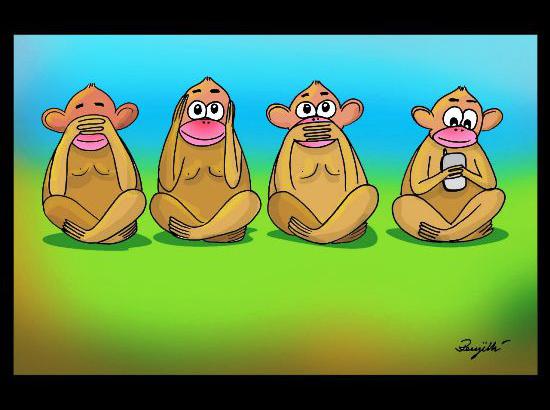
When the fourth monkey joins Gandhi’s 3-wise monkeys
When the fourth monkey joins Gandhi’s 3-wise monkeys
We all have heard about the ‘three wise monkeys’ of Mahatma Gandhi representing the principle – covering his eyes, who sees no evil, covering his hears, who hears no evil, covering his mouth who speaks no evil. These three wise monkeys sometimes called the three mystic apes are a pictorial maximum.
There are various meanings ascribed to the monkeys and the proverb including associations with being good mind, speech and action.
Mahatma Gandhi’s one a notable exception to his lifestyle of non possession was a small statue of the three monkeys.
Today, a larger representation of the three monkeys is prominently displayed at the Sabarmati Ashram in Ahmadabad, Gujarat, where Gandhi lived from 1915 to 1930 and from where he departed on his famous salt march.
In the Buddhist tradition, the tenets of the proverb – see no evil, hear no evil, speak no evil – are about not dwelling on evil thoughts. The western world both the proverb and the image are often used to refer to a lack of moral responsibility on the part of the people who refused to acknowledge impropriety, looking the other way or feigning ignorance. It may also signify a code of silence in gangs or organized crime.
Outside Japan the monkey’s name are sometimes given as Mizaru, Kikazaru and Mazaru as the last two games were corrupted by the Japanese originals. The monkeys are Japanese macaques a common species in Japan.
Sometimes there is a fourth monkey depicted, Shizaru, who symbolizes the principle of “do no evil”. He may be shown crossing his arms or covering his genitals. In another variation, a fourth monkey is depicted with a sulking posture and the caption “have no fun”. Yet another variation has the fourth monkey hold its nose to avoid a stench and has been dubbed “smell no evil” accordingly.
Osho Rajneesh gave his own meaning regarding this. The first monkey denotes ‘Don’t listen to the truth because it will disturb all your consoling lies. The second monkey denotes ‘Don’t look at the truth’; otherwise, your God will be dead and your heaven and hell will disappear’. The third monkey denotes ‘Don’t speak the truth’; otherwise, you will be condemned, crucified, poisoned, tortured by the whole crowd, the unconscious people. You will be condemned, don’t speak the truth!’ The fourth monkey denotes “Keep your pleasures, your joys, hidden. Don’t let anybody know that you are a cheerful man, a blissful man, an ecstatic man, because that will destroy your very life. It is dangerous”.
According to Osho, the monkey symbolism originated in ancient Hindu tradition and Buddhist monks spread this symbolism across Asia. The original Hindu and Buddhist version contains four monkeys and the fourth monkey covers his genitals. The Buddhist version means this as “Don’t do anything evil”.
With the introduction of social media on small hand electronic gadgets, hardly anyone pays any attention to these principles rather making mockery by adding the fourth monkey which I received on my mobile. The fourth one added is using the mobile, ignoring the other three monkeys giving a strong message when the life has become hell on this planet earth – see no evil, hear no evil, speak no evil.
Frankly speaking, whatever may be the background of the three monkeys of Mahatama Gandhi but its statues used to be a part of each house and schools as a motivational force.
But Google helped me to clear my curiosity to know more about the fourth monkey on its search engine that in Hindu original version the meaning of the fourth monkey sitting with hands on his lap, is totally different from the popular Buddhist version. It means, “Hide your pleasures. Hide your enjoyment, don’t show it to anybody.




